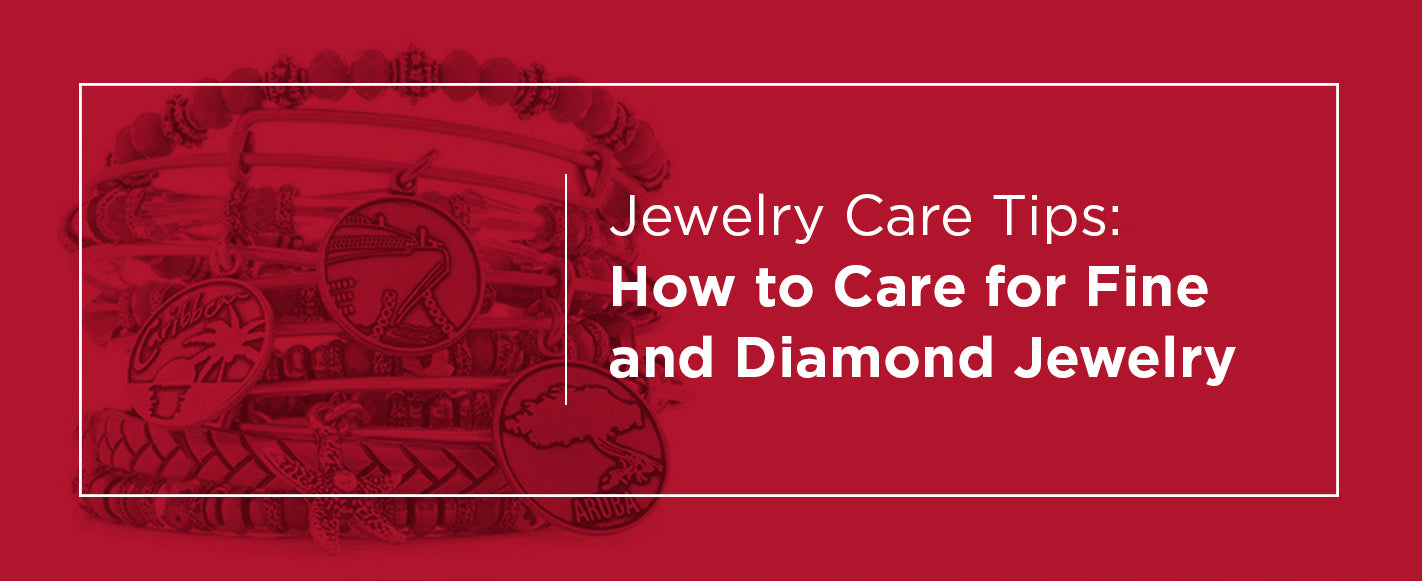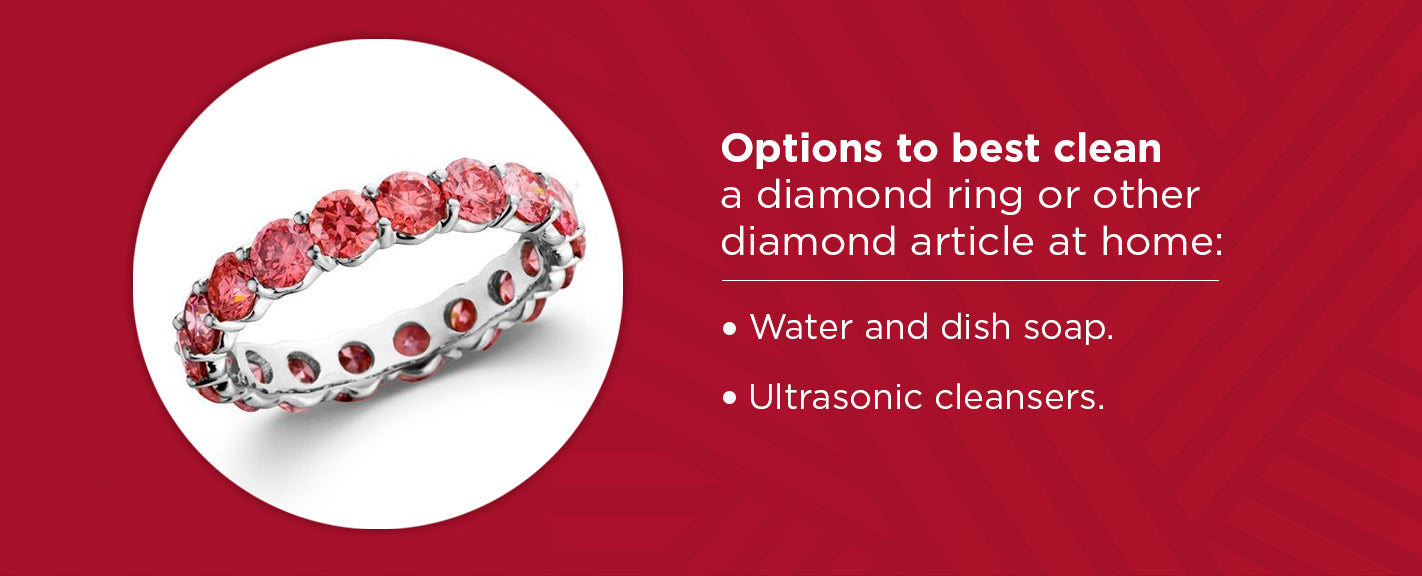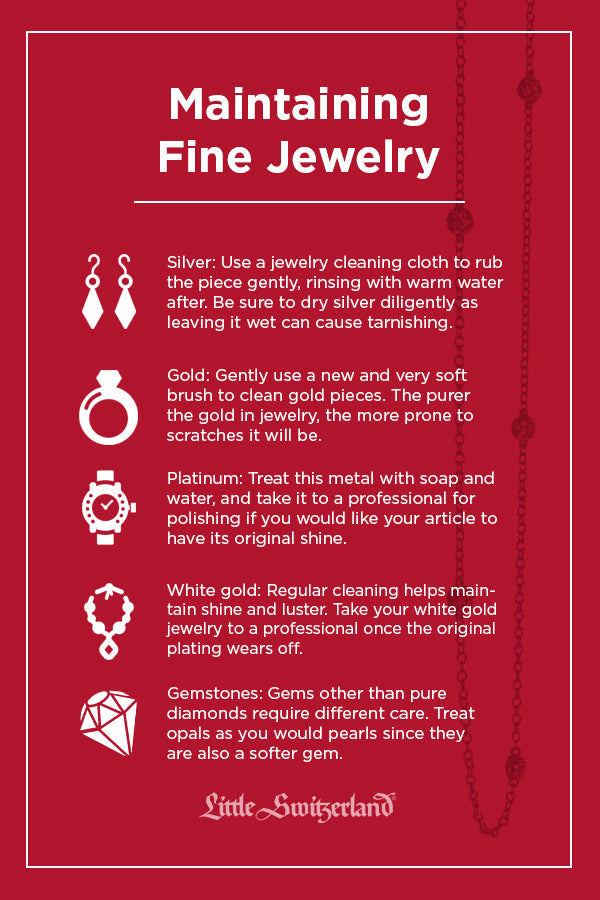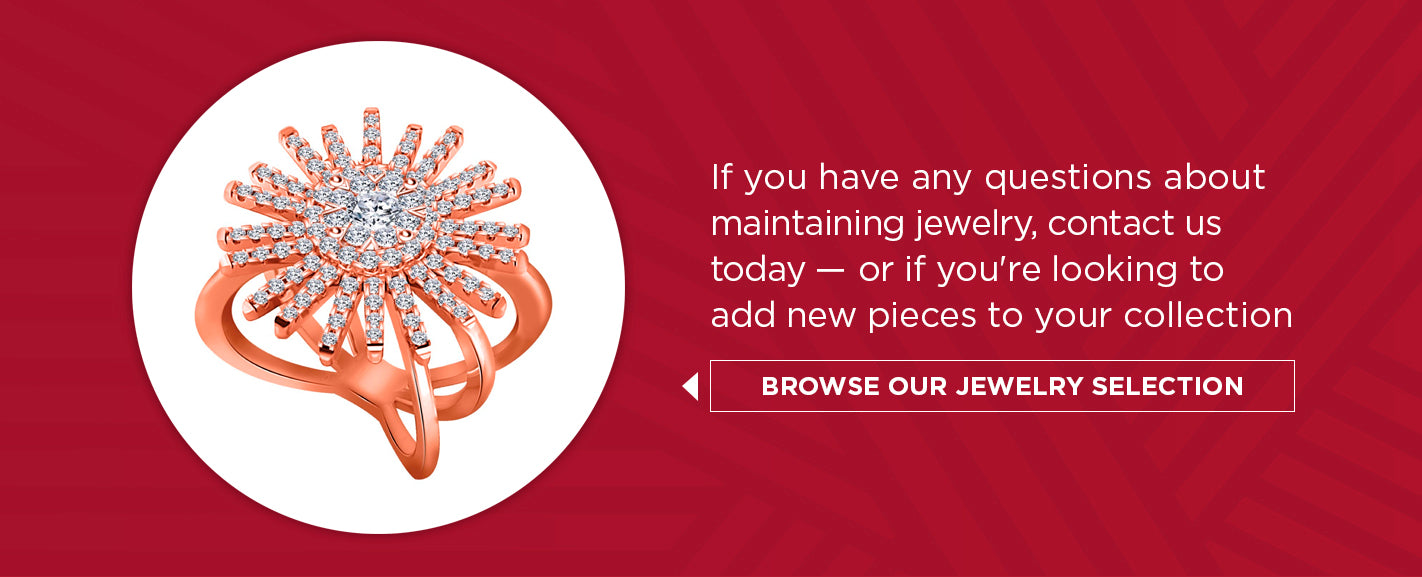Jewelry Care Tips: How to Care for Fine and Diamond Jewelry

You take pride in your jewelry and want to show it off. Whether you wear your pieces every day or save them for special occasions, you might notice that eventually, your jewelry has lost some of its brilliance.
Luckily, you can restore your pieces to their original shine and sparkle. From cleaning and storing your jewelry at home to taking it with you while traveling, we know you care about your rings, necklaces, earrings and bracelets.
Follow our jewelry care tips below to find out the best ways to maintain your most exquisite pieces.
How to Clean Diamonds
From rings to earrings, necklaces and bracelets, one or many of your pieces may contain diamonds. While these beautiful gemstones add a radiant touch to any look, daily or regular wear of diamond jewelry contributes to clouding. Dust and pollution over time also dull the brilliance of your diamonds, which will leave you wondering how to care for your diamond ring and other valuable pieces.
You do not need to lock away your precious collection, to keep it clean. If you know how to clean your diamonds properly, you will help them retain their clarity.

If you're looking for options on how to best clean a diamond ring or other diamond jewelry at home, here are a few options:
- Water and dish soap: Add a few drops of mild dish soap to a small bowl of water. Then lightly brush with a use a soft-bristle brush to remove dirt, oils and other substances from your jewelry. Be sure to use a basic dish soap that does not contain detergents, as those could cause damage to your jewelry.
- Ultrasonic cleansers: Some at-home methods for cleaning your diamond ring, necklace, earrings or bracelet may recommend an ultrasonic cleaner. While ultrasonic cleaners can shake dirt loose from your jewelry, you also risk loosening the diamond from its setting, especially in older pieces. Try cleaning your jewelry by hand first, and if you are not satisfied with the results, consider taking your diamond pieces to a professional for proper cleaning.
If your diamond jewelry is delicate or vintage, it may be best to use the mild solution of dish soap diluted in water. Use caution with vintage jewelry — you should not soak antique articles. It may be best to take vintage items to a professional instead of attempting an at-home method of cleaning jewelry.
Once you've cleaned your jewelry, rinse the pieces under warm running water. You can also use a glass or bowl of water to avoid losing smaller items if your sink drain cannot close. After washing, be sure to dry your jewelry with a soft and lint-free cloth thoroughly.
While maintaining the appearance of your diamond is an essential step in caring for jewelry, you should also check that your gemstones are adequately and securely set so there is less risk of losing a stone during cleaning or regular wear. Little Switzerland's expert technicians will secure settings in your diamond ring, so there is no need to worry about losing these precious gems.
How to Care for and Clean Pearl Jewelry
Once you've made your diamonds shine again, you may examine your collection and decide to clean your other pieces. If you have pearls, knowing how to clean your pearl necklace or other pearl jewelry is important. Because pearls are more porous and fragile than some other gemstones, the cleaning process is a bit different and takes a bit more care.
Soaking or rinsing a string of pearls in water will weaken the silk thread that holds them together. Instead, lay them on a soft, non-abrasive cloth and gently clean your pearl jewelry with a new makeup brush and soapy water. The fine bristles will treat your pearls more gently than a toothbrush or other soft cleaning brush would.
Even though you are not soaking your pearl jewelry, allow your string of pearls to dry thoroughly before handling because the wet silk thread that holds the strand together is prone to stretching and attracting dirt even when damp.
Despite your best efforts, silk thread will still stretch over time with regular use. If you wear your pearl jewelry often, be sure to have it restrung once a year. If you are unfamiliar with pearl jewelry and are not sure when to have it restrung, check between the pearls. Excessive thread between the gems means it's time to have your pearl necklace or bracelet restrung. Be sure that the technician creates knots between each gem when restringing. The knots prevent you from losing all of your gemstones if the string breaks and protects the pearls from damaging each other.
After learning how to maintain your diamond and pearl pieces correctly, you will want to go through the rest of your jewelry box to help your whole collection regain its brilliance.

If you have other fine pieces that you wish to clean at home, we advise not using the same method as you would for diamonds or pearls on every part of your collection. Every material is different and requires various cleaning processes.
- Silver: Use a jewelry cleaning cloth to rub the piece gently, rinsing with warm water after. Follow that with a liquid cleaner specifically for silver if your items have excessive tarnishing. Be sure to dry silver diligently as leaving it wet can cause tarnishing.
- Gold: Gently use a new and very soft brush to clean gold pieces. The purer the gold in jewelry, the more prone to scratches it will be. If your gold is a lower alloy, it will be harder than 24 karat gold and less likely to scratch, though you should still carefully use a soft brush when cleaning.
- Platinum: Like pure gold, this material will not tarnish. Platinum can still scratch, though it will not wear down over time. Treat this metal with soap and water, and take it to a professional for polishing if you would like your article to have its original shine.
- White gold: Regular cleaning helps maintain shine and luster. Take your white gold jewelry to a professional once the original plating wears off. With excessive wear, white gold jewelry begins to show its original yellow or gold color, and a technician can re-plate these pieces.
- Gemstones: Gems other than pure diamonds require different care. Some may react with ammonia, so it is best to use mild dish soap or take them to a professional. Treat opals as you would pearls since they are also a softer gem.
Your beautiful jewelry can last a lifetime with proper care. While specific materials require specific maintenance, there are a few general steps you can take to care for your collection:
- Clean at-home regularly: Remember to clean pieces after certain activities or outings, like visiting the beach, though if you can avoid it, you should not wear jewelry while exercising or doing other activities that may damage your items. Be sure to wipe jewelry with a soft, damp cloth especially if your pieces have come in contact with lotion, sand and dirt or other substances.
- Visit a professional: Remember that even though there are at-home methods to clean jewelry, trained technicians are there to help. Take your jewelry to a professional every six months to a year. Whether a technician is re-plating, re-polishing or reinforcing a setting, your jewelry will come out looking like new.
You want your pieces to look radiant when you wear them, and by regularly caring for these items, you can help them last a long time.
Storing Your Jewelry Carefully and Correctly
Along with regular cleaning, it is just as important to store pieces properly as it is to maintain them. It is essential to clean your jewelry, but all of your efforts may go to waste if you improperly store pieces when you aren't wearing them. We recommend taking the following steps when storing jewelry:
1. Carefully clean jewelry before storing.
Follow the jewelry care tips above for specific methods on removing dirt, oils and other substances from your pieces. Storing jewelry without removing these substances can cause damage over time.
2. Do not store damp or wet jewelry.
Dry pieces with a soft, non-abrasive, lint-free cloth and leave them in a safe place to air dry if they are more delicate. Damp jewelry can tarnish or corrode depending on the material, and they will create a humid environment in storage, which you should avoid for most pieces.
3. Just as you shouldn't store damp jewelry, you shouldn't store jewelry in a damp place.
Avoid storing jewelry in your bathroom because the humidity will have the same impact as leaving your pieces wet.
4. Help keep your pieces dry by storing them with an absorbent.
If you use an absorbent material such as charcoal, chalk or silica gel, it will help remove moisture from the air and preserve your jewelry. There is an exception to this rule, though.
5. Do not use absorbent materials when storing pearl or opal jewelry.
Dry conditions can cause these gems to become brittle. Some individuals store their opals in or with a glass of water, but that may only be necessary in very arid climates.
6. Sort your jewelry and store them by type.
Diamonds, for example, are a hard stone that can scratch delicate materials like purer gold, opals and pearls. Separately store pieces that can damage each other in different jewelry boxes or bags.
7. Choose storage with a soft fabric lining.
The lining will prevent scratches or damage. If you are able, store pieces separately so they cannot tangle or damage each other. Carefully wrap them in tissue or, for pearls especially, a soft bag. Use an anti-tarnish bag for silver.
8. Avoid excessive light and heat when storing.
Bright light and heat for extended periods will weaken and discolor certain gemstones. Too much light bleaches pearls and ivory while it darkens other materials like amber. Storing your collection in a closed jewelry box or safe will prevent light exposure. Ensure that you do not leave the box or safe somewhere too hot.
9. Hang with care.
If your jewelry box has hooks to hang necklaces, only place one necklace per hook. Limiting the number of pieces on a single hook to one will minimize tangling and damage.
While maintaining your jewelry and correctly storing pieces is essential, it is also vital to protect your most valuable and precious pieces. A locking jewelry box or safe is best for these pieces, though be sure not to lock them away all the time. Take them out for regular cleaning and professional maintenance, which will require careful transportation.
Traveling With Jewelry
Now that you know how to keep your jewelry looking like new, you will want to show off your pieces more. You may also have to transport jewelry to professionals for cleaning and maintenance. No matter the reason for moving your pieces, it is necessary to know the safest ways to do so.
- Minimize what you bring. Choose one or two pieces that you can wear throughout your trip and wear them when you travel.
- Keep your precious jewelry by your side. You don't want to risk losing your pieces if your luggage is lost.
- Use a jewelry roll. These pouches have different compartments to make sure your jewelry is separate and secure. They are flatter than other containers too, making them great for traveling.
- Find a way to keep your jewelry separated. Jewelry cases or boxes will protect your pieces, but from there, you should separate articles into bags. Plastic bags work in a pinch, but using fabric bags will further protect your collection.
There are a lot of DIY methods for traveling with jewelry, but proceed with caution. Using contact lens cases or lip balm tubes could be risky if these containers are not clean. If residue inside containers makes contact with jewelry, it could damage pieces. Your best bet is to purchase cases specifically designed to protect and store your jewelry.

If you are moving or need to transport most or all of your pieces for any reason, you will have to be more diligent than if you were traveling with an item or two. You can keep your collection in your jewelry box, but be sure to wrap jewelry individually. Secure them in the case, then secure the box itself by wrapping lids or drawers so that they do not open during transport. When you arrive at your new location, be sure to check that your pieces have survived the journey and care for them as usual.
What to Remember When Caring for Jewelry
It's crucial to know how to clean your jewelry, but it's just as vital to know what to avoid when caring for items. We do not recommend any of the following:
- Using chlorine bleach
- Abrasives like baking soda
- Wearing jewelry when showering, swimming or working with harsh chemicals
- Allowing pieces to come in contact with perfumes, makeup, lotions or perspiration
- Exposure to excessive light and heat when wearing or storing
You will minimize potential damage to your pieces by avoiding the above, but there are also regular steps you should take to maintain your collection.
- Handle your jewelry as minimally as possible. Handling pieces is unavoidable when putting jewelry on, wearing them and removing articles. Wipe jewelry before storing and do not touch them again until you have to.
- Use a new, soft-bristle brush when cleaning jewelry. You may be tempted to use an old brush, which some suggest, but old brushes come with risks. Old and used toothbrushes contain toothpaste residue, which is an abrasive that can harm jewelry. Other old brushes may lose bristles. Loose bristles may get caught in jewelry chains and settings, so the safest choice to clean pieces is a new and high-quality brush.
- Take antique jewelry to professionals. Older pieces require different care, and a trained professional will know how to handle vintage jewelry. Provide any information you have about your vintage articles so the technician can treat these items effectively.
- Use a glass or close the drain in your sink when rinsing jewelry. Smaller pieces can slip out of your hand when wet and soapy. Avoid losing your valuable pieces by checking the drain of your sink or using a bowl in a safe area.
One of the critical jewelry care tips is to know your pieces. Take your pieces for jewelry reports or store any documents you received when purchasing your jewelry in a safe place. For security reasons, you should store these documents separate from your jewelry. Review these documents and refresh your knowledge of how to care for different metals and gems. If you know what materials your pieces contain and what those different materials require, you can take the appropriate steps to care for your most precious jewelry.
Let Little Switzerland Help You Maintain Your Jewelry
Properly caring for your jewelry will help your items maintain their precious beauty and last for years to come. If you have any questions about maintaining jewelry, contact us today — or if you're looking to add new pieces to your collection to care for, browse our jewelry selection.



